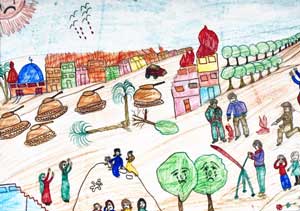Solidarity with children of Gaza
Museum censors artwork of war, occupation
By
Megan Spencer
Published Sep 24, 2011 9:21 AM
The Museum of Children’s Art in Oakland, Calif., cancelled an exhibit of artwork created by Palestinian children living in the occupied Gaza Strip. The exhibit, entitled “A Child’s View from Gaza,” features artwork made during Operation Cast Lead, the Israeli assault on Gaza from December 2008 until January 2009. Amnesty International reports that the assault left 1,400 Palestinians dead, including more than 300 children. Thousands more were injured and traumatized.
|
Artwork from ‘A Child’s View of Gaza’
will be
exhibited in Oakland, Calif.
|
Just two weeks before the exhibit’s Sept. 24 opening, the museum’s board of directors abruptly notified the Berkeley Middle East Children’s Alliance, the group organizing the exhibit, that the board was cancelling the event due to the “graphic” and “violent” nature of the artwork, which they suggested was “inappropriate” for children to view.
Graphic violence is a reality for Palestinian children, who live with the horrors of occupation every day. Children residing in Gaza and the West Bank face malnutrition, displacement from their homes and villages, inadequate access to health care and education — due to the economic blockade and military checkpoints — and the trauma of seeing countless friends and family members killed by occupation forces.
Ziad Abbas, MECA’s associate director, told the Electronic Intifada that local mental health initiatives and art-based organizations in Gaza started working with traumatized children after Operation Cast Lead, in an effort to help them cope with fear and trauma. Palestinian children have long used art to convey their feelings about the reality of living under military siege. Once again pro-Israeli organizations have silenced them, as they try to squash any criticism of Israel and its brutal occupation.
While some parents may have legitimate concerns about their children viewing artwork illustrating violence and death, the museum’s previous exhibits indicate that the decision to cancel the event was not simply a matter of protecting youth from graphic material. MOCHA has exhibited the artwork of Iraqi children who endured the 2003 U.S.-led invasion of their homeland as well as artwork made by children during World War II.
Barbara Lubin, the executive director of MECA. said: “Anybody who knows this issue knows that the Jewish Federations of North America and the Jewish Council for Public Affairs have launched a multimillion-dollar project to combat what they call the ‘delegitimization’ of Israel. … They try to suffocate the boycott, divestment and sanctions movement and censor Palestinian cultural initiatives. What they’re doing is financing the work of silencing and shutting down anyone who wants to talk about what’s really happening to Palestinians.”
Just like all children, Palestinian children must have their voices and experiences affirmed. By censoring the artwork of Gazan children, MOCHA missed an important opportunity to raise consciousness among children in the United States. Given that the U.S. spends more than $7 billion a year supporting the Israeli military, children here should see the artwork of children in Gaza that reveals the horrors they are forced to endure.
Children here should be raised with an awareness about the suffering that occurs in the world, particularly because of the U.S. government’s pro-war policies. If children in the U.S. saw this artwork, perhaps they would help to cultivate a more compassionate and conscious culture, rather than one which glorifies racism and war.
To ensure that the Palestinian children artists will not be silenced, MECA has arranged for the exhibit to be presented in the courtyard outside of MOCHA on the scheduled opening date, Sept. 24.
The writer is a youth activist and artist in Detroit.
Articles copyright 1995-2012 Workers World.
Verbatim copying and distribution of this entire article is permitted in any medium without royalty provided this notice is preserved.
Workers World, 55 W. 17 St., NY, NY 10011
Email:
[email protected]
Subscribe
[email protected]
Support independent news
DONATE


